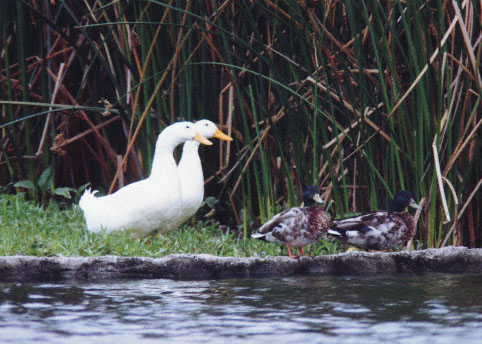Stacking Teleconverters
Teleconverters have always been a mystery to me when I first started photography. It can magically double the focal length of any lens, thus magnify the image. Yet, most photographers try to persuade me from using one. And when I ask what would one or more teleconverters do to a lens and image quality, most reply I get is that I will simply get bad images.
It is true that most teleconverters will degrade image quality. It is commonly agreed upon that the more glass between the world and the film, the worse the image quality. And teleconverters use glass to produce its magnification. The deterioration is especially apparent if the glass is not made for the lens.

Some photographers feel that they can get away from using teleconverters because they can simply move closer to their subject. However, I can assure them that they can not have moved any closer to the subjects in the picture above. I took the above picture at a local park by my house. There is a giant pond between the subjects and I. Hard-core photographers would probably laugh at me and insist on swimming closer. However, swimming at this local park is illegal.
I produced the above picture with my Canon 300mm f/4 L, my Quantaray 2x AF teleconverter, my Sigma 1.4x AF teleconverter, and my Canon Rebel G camera. This setup was mounted on a tripod and manually focused. This combination gave me a 840mm f/11.2 lens. (How did I get these magic numbers? I will explain in a second.) Without these converters, I would not have been able to capture the image above.
A professional photographer can get close (in distance) to my result with a Canon 600mm f/4 L lens. But that lens will cost him $7799 from B&H catalog in July 1999. My combination costed me $1059.90, including camera:
Canon 300mm f/4 L (used) $650.00
Quantaray 2x AF teleconverter (new) $ 79.95
Sigma 1.4x AF teleconverter (used) $ 90.00
Canon Rebel G camera (new) $239.95
--------
Total: $1059.90
I have to admit, image quality is most likely better with the Canon 600mm f/4 L lens. But $7000 difference, I can live with that.
It's all math
I have asked many photographers exactly what focal length and aperture my lens would be with teleconverters. The answer I always get is that with a 1.4x teleconverter, the lens lose one stop of light and becomes 1.4 times longer. With a 2x teleconverter, the lens lose two stops of light and becomes 2 times longer. But no one ever explained to me how they got these answers. They are just magic numbers.
I ended up doing my own research and found that it is all a number game. It turned out that given a lens or mirror of focal length (L) and aperture diameter (D), the f-stop number (f) is defined by
L
f = -
D
From this equation, we can calculate the maximum aperture diameter of my Canon 300mm f/4 L lens:
L
D = -
f
300
D = --- = 75
4
With the aperture diameter, we can now calculate any teleconverter(s) and lens combination.
Canon 300mm f/4 L and Sigma 1.4x teleconverter
L = 300mm x 1.4 = 420mm
420
f = --- = 5.6
75
Canon 300mm f/4 L and Quantaray 2x teleconverter
L = 300mm x 2 = 600mm
600
f = --- = 8
75
Canon 300mm f/4 L, Sigma 1.4x teleconverter, and Quantaray 2x teleconverter
L = 300mm x 1.4 x 2 = 840mm
840
f = --- = 11.2
75
Canon 300mm f/4 L, Quantaray 2x teleconverter, and Kenko 2x teleconverter
L = 300mm x 2 x 2 = 1200mm
1200
f = ---- = 16
75
Ordering makes a difference
After stacking multiple teleconverters with my Canon 300mm f/4 L lens, I have noticed that ordering of the teleconverter makes a difference on the sharpness of the image. When I first started using multiple teleconverters, I attached the components in the following order: Canon 300mm f/4 L lens, Quantaray 2x AF teleconverter, Sigma 1.4x AF teleconverter, and Canon Rebel G camera. One night, I was sitting in my living room and playing with the combination, I found that by swaping the order of the two teleconverters, I get a noticable sharper image in my view finder. Ever since then, I have been using the set in the following combination: Canon 300mm f/4 L lens, Sigma 1.4x AF teleconverter, Quantaray 2x AF teleconverter, and Canon Rebel G camera.
Related Links
256 Users Online
|
$10000-above $5000-$9999 $2000-$4999 $1000-$1999 $500-$999 $200-$499 $100-$199 $50-$99 $25-$49 $0-$24 Gift Certificate |
|




